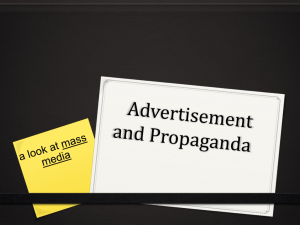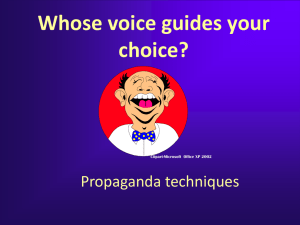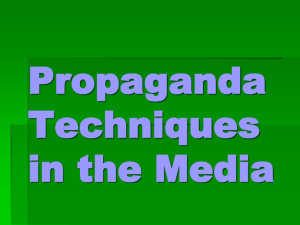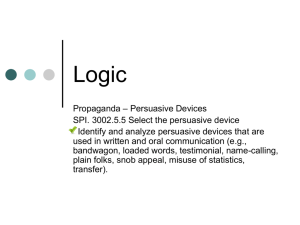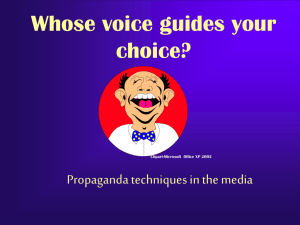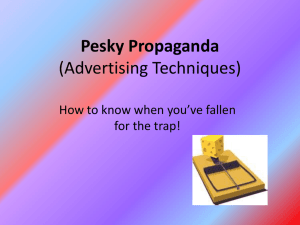Propaganda Techniques
advertisement
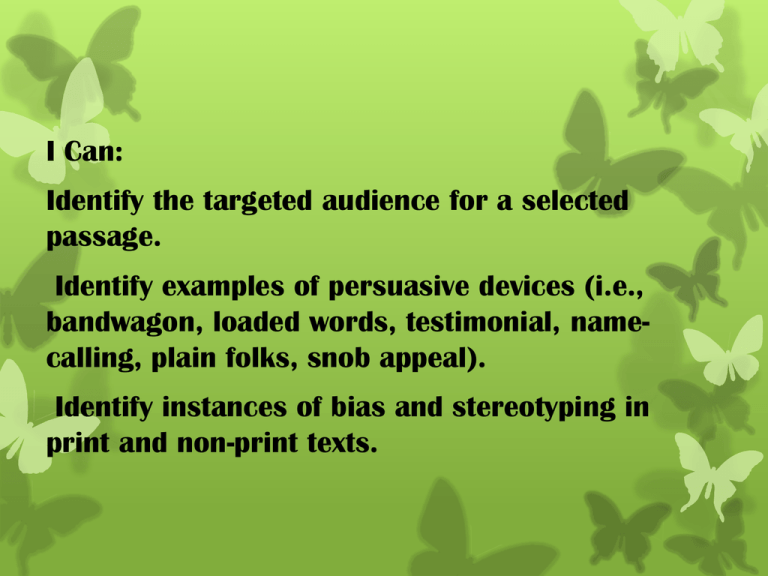
I Can: Identify the targeted audience for a selected passage. Identify examples of persuasive devices (i.e., bandwagon, loaded words, testimonial, namecalling, plain folks, snob appeal). Identify instances of bias and stereotyping in print and non-print texts. Propaganda Techniques What you should know! How do you decide who is the best candidate… Clipart-Microsoft Office XP 2002 or which is the best toothpaste ? Clipart-Microsoft Office XP 2002 Looking for facts to back up your choice is an excellent idea, but find out who is presenting those facts. Clipart-Microsoft Office XP 2002 Are they facts at all, or is the advertiser using propaganda techniques to persuade you? Clipart-Microsoft Office XP 2002 What are Propaganda techniques? • Propaganda is designed to persuade. • Its purpose is to influence your opinions, emotions, attitudes, or behavior. (It appeals to the emotions not the intellect.) • It can be negative or positive. • The purpose is to benefit the sponsor. • It seeks to “guide your choice.” Characteristics of Propaganda • In advertising the purpose is to claim “superiority” in order to sell product. • Weasel Words - modifiers that look substantial but are meaningless. • Makes audience believe in something or want to do something. Who uses Propaganda? •Military •Media •Advertisers •Politicians •You and I What are some of the techniques used to persuade us? •Bandwagon •Name-calling •Testimonial •Glittering Generality •Plain-folks appeal •Emotional words (Loaded Language) •Faulty Reasoning •Fear •Snob Appeal • Transfer • Slogan • Wit and Humor • Rewards • Big Lie • Scapegoat • Patriotism • Advertisers know how to • target their audiences • use appropriate persuasive technique Audience? Audience? Bandwagon •Everybody is doing this. •It aims at persuading the people to do a certain thing because many other people are doing it. •If you want to fit in, you need to “jump on the bandwagon” and do it too. •The implication is that you must JOIN in to FIT in. Clipart-Microsoft Office XP 2002 Bandwagon • Gives impression that you will be left out if you don’t do what you are being persuaded • Example: “See why so many women have switched” (Shampoo advertisement) • Often uses weasel words For example: If the whole world uses this VISA card, you must need one too. Bank of the World Visa CardYou can use it from Tennessee to Timbuktuanywhere you travel in whole wide world !! Sign up today at www.bowvisa.com Clipart-Microsoft Office XP 2002 Everyone in Auburn is supporting Bob Riley. Shouldn’t you be part of the winning team? An example can be a soft drink advertisement wherein a large group of people is shown drinking the same soft drink. People feel induced to opt for that soft drink as it is shown to be consumed by many. Now it’s your turn: Write two examples of Bandwagon technique. Pass your paper to the person in front of you. Read the examples and determine if they are Bandwagon technique examples. Name-calling •A negative word or feeling is attached to an idea, product, or person. • If that word or feeling goes along with that person or idea, the implication is that we shouldn’t be interested in it. Name - Calling • A way of smearing an opponent • Intent is to damage opponent • It also arouses suspicion of opponent • Intention is to create an uneasy feeling • Used by politicians and product companies Name - Calling In a campaign speech to a logging company, the Congressman referred to his environmentally conscious opponent as a "tree hugger." For example: Do we want a mayor who will leave us in debt? Clipart-Microsoft Office XP 2002 Spending grew 100% under Mayor Moneybags! Now it’s your turn: Write two examples of Name-Calling technique. Pass your paper to the person behind you. Read the examples and determine if they are Name-Calling technique examples. Testimonial •A famous person endorses an idea, a product, a candidate. •If someone famous uses this product, believes this idea, or supports this candidate, so should we. Testimonial • Statement endorsing an idea/product by a prominent person. • Product can be inside or outside particular field. • Musical artists, • Sports giants, • Actors/actresses For example: If we drink milk we will all be as famous as Molly the model. Clipart-Microsoft Office XP 2002 Molly the Model asks, “Got Milk?” Now it’s your turn: Write two examples of Testimonial technique. Pass your paper to the person in front of you. Read the examples and determine if they are Testimonial technique examples. Glittering Generality •A commonly admired virtue is used to inspire positive feelings for a person, idea, or product. •Words like truth, democracy, beauty, timeless are examples of those general terms. Glittering Generalization • Weasel words used. • Statement jumps from a few cases to all. • “Glittering” because it’s falsely attractive • Often used by politicians • Uses a “positive” connotation to encourage audiences to accept the product or person without examining the evidence. Glittering Generalization Have it your way! This slogan implies “choice” which is a founding principle of democracy. For example: If you want to be brighter, you’ll support Bill Brite. Clipart-Microsoft Office XP 2002 Look on the bright side! Vote for Bill Brite ! Now it’s your turn: Write two examples of Glittering Generalization. Pass your paper to the person behind you. Read the examples and determine if they are Glittering Generalization technique examples. Plain-folks appeal This idea, product, or person is associated with normal, everyday people and activities. Plain Folks • Identifies product/idea with a locality or country • Practical product for ordinary people. Like a good neighbor… For Example: We want a Jim Smith, a mayor who supports the regular American worker. Clipart-Microsoft Office XP 2002 Vote for Smith Now it’s your turn: Write two examples of Plain Folks technique. Pass your paper to the person behind you. Read the examples and determine if they are Plain Folks technique examples. Transfer •Symbols, quotes, or images of famous people are used to convey a message. •The message may not necessarily be associated with them. •Using the names or pictures of famous people, but not direct quotations Transfer • Using the product will make you look or feel like the people in the ad Transfer • Love/ Popularity • Fame • Wealth • Power Transfer This technique relies heavily on symbolism. *Love/ Popularity *Fame *Wealth *Power During the Kerry vs. Bush campaign an e-mail through the internet showed similar physical characteristics between John Kerry and Frankenstein. For example: Joe uses symbols of America to tie his restaurant to American values for Independence Day. Celebrate the American Way this 4th of JulyEat at Joe’s Joe’s Barbeque Clipart-Microsoft Office XP 2002 Now it’s your turn: Write two examples of Transfer technique. Pass your paper to the person in front of you. Read the examples and determine if they are Transfer technique examples. Emotional words (Loaded Language) •Words that leave us with positive feelings are used to describe a product, person, or idea. •We associate those words and, therefore, those positive feelings with the product. •A person is made to have strong feelings about a situation or product Emotional Words (Loaded Language) • Words that will make you feel strongly about someone or something (fear, desire for success, excitement, being part of a group) • “If you want to be cool, wear this jacket” Emotional Words (Loaded Language) For example: What feelings are inspired by the words “true love”? If you wear this cologne will someone fall in love with you? True Love Clipart-Microsoft Office XP 2002 Now it’s your turn: Write two examples of Loaded Language. Pass your paper to the person behind you. Read the examples and determine if they are Loaded Language technique examples. Faulty Reasoning •Factual supporting details are used though they do not support the conclusion. It works like this: •Christians believe in God. •Muslims believe in God. •Christians are Muslims. For example: Does this mean that teachers need medication to keep their cool during the school day ? More teachers recommend Calmme to help them make it through the day Clipart-Microsoft Office XP 2002 Now it’s your turn: Write two examples of Faulty Reasoning. Pass your paper to the person behind you. Read the examples and determine if they are Faulty reasoning examples. Fear •Our fears are displayed. •Ideas, candidates, or products are shown to put our fears to rest. For example: If you use Safety Ware it will keep people from stealing your identity-or will it? Clipart-Microsoft Office XP 2002 Guard against Identity theft Use Safety Ware www.safetyware.com Now it’s your turn: Write two examples of Fear. Pass your paper to the person behind you. Read the examples and determine if they are Fear technique examples. Snob Appeal • Snob appeal is reverse of plain folks. • It indicates that buying a certain product will make you stand out from the rest, as the masses won’t afford to buy it. Snob Appeal • Aims to flatter • Makes assumption/ insinuation that this product/idea is better than others… • Thus, those that use it are too. • “Avant Garde” ahead of the times. Example The Ultimate driving machine Examples: • Dog food is served in a crystal goblet. • A credit card company offers gold and platinum cards rather than the original yellow, blue and red. • The family passes the word that “He went to Jared.” Now it’s your turn: Write two examples of Snob Appeal. Pass your paper to the person behind you. Read the examples and determine if they are Snob Appeal technique examples. Slogan • A catchword or phrase loaded with emotion • Often sells through repetition • Clever and easy to remember • Stays with you a long time • Often a melody you already know “Trust Sleepy’s For the ‘rest’ Of your life” Slogan: “Can you hear me now?” Relevant facts • Advertisers spend about $200 billion a year on TV advertising • The average cost for Super Bowl ads is $2.6 million per 30 second spot • The average American watches about 24,000 TV commercials a year http://television-commercial.net/ Making Connections • What is your favorite jingle? • What slogan for a product do you find yourself saying? • What TV commercial has influenced you to make a purchase? • Since Taylor Swift and Lady GaGa shop at Kroger, does that mean we should too? Reflection “Persuasion is all around you” In addition to TV commercials, where else do you see persuasion all around you? Is that persuasion influencing you or your family in any way? Explain. How do we make sure that we are making informed choices, Clipart-Microsoft Office XP 2002 instead of allowing others to sway us in our decision-making? We make our own choices when … •we read and listen to reliable sources, •we watch for combinations of truths and lies, •we check for hidden messages, •we watch for use of propaganda techniques, and, most importantly, www.scottish.parliament.uk/ educationservice WHEN WE LISTEN TO OUR OWN VOICES ! 1) Audience? Purpose? Persuasive technique? 2) Audience? Purpose? Persuasive technique? 3) Audience? Purpose? 4) Audience? Purpose? 5) Audience? Purpose? Persuasive technique? 6) Audience? Persuasive technique? Get out one sheet of paper and copy the following chart. The End Whose Voice Did You Hear? AD # 1 2 3 4 5 WHO published this ad? WHAT is it about? WHERE did you find it? HOW did the advertiser use propaganda techniques to persuade?
